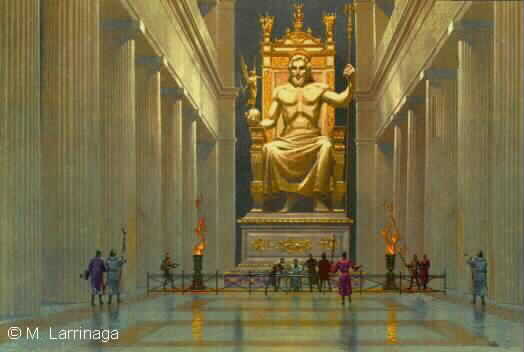

 |

|

|
This is the statue of the god in whose honor the Ancient Olympic games were held. It was located on the land that gave its very name to the Olympics. At the time of the games, wars stopped, and athletes came from Asia Minor, Syria, Egypt, and Sicily to celebrate the Olympics and to worship their king of gods: Zeus.
Location
At the ancient town of Olympia, on the west coast of modern Greece, about 150 km west of Athens.
History
The ancient Greek calendar starts in 776 BC, for the Olympic games are believed to have started that year. The magnificent
temple of Zeus was designed by the architect Libon and was built around 450 BC. Under the growing power of ancient
Greece, the simple Doric-style temple seemed too mundane, and modifications were needed. The solution: A majestic statue.
The Athenian sculptor Pheidias was assigned for the "sacred" task, reminiscent of Michelangelo's paintings at the Sistine
Chapel.
For the years that followed, the temple attracted visitors and worshippers from all over the world. In the second century BC repairs were skillfully made to the aging statue. In the first century AD, the Roman emperor Caligula attempted to transport the statue to Rome. However, his attempt failed when the scaffolding built by Caligula's workmen collapsed. After the Olympic games were banned in AD 391 by the emperor Theodosius I as Pagan practices, the temple of Zeus was ordered closed.
Olympia was further struck by earthquakes, landslides and floods, and the temple was damaged by fire in the fifth century AD. Earlier, the statue had been transported by wealthy Greeks to a palace in Constantinople. There, it survived until it was destroyed by a severe fire in AD 462. Today nothing remains at the site of the old temple except rocks and debris, the foundation of the buildings, and fallen columns.
Description
Pheidias began working on the statue around 440 BC. Years earlier, he had developed a technique to build enormous gold
and ivory statues. This was done by erecting a wooden frame on which sheets of metal and ivory were placed to provide the
outer covering. Pheidias' workshop in Olympia still exists, and is coincidentally -- or may be not -- identical in size and
orientation to the temple of Zeus. There, he sculpted and carved the different pieces of the statue before they were assembled
in the temple.
When the statue was completed, it barely fitted in the temple. Strabo wrote:
".. although the temple itself is very large, the sculptor is criticized for not having appreciated the correct proportions. He has shown Zeus seated, but with the head almost touching the ceiling, so that we have the impression that if Zeus moved to stand up he would unroof the temple."
Strabo was right, except that the sculptor is to be commended, not criticized. It is this size impression that made the statue so wonderful. It is the idea that the king of gods is capable of unroofing the temple if he stood up that fascinated poets and historians alike. The base of the statue was about 6.5 m (20 ft) wide and 1.0 meter (3 ft) high. The height of the statue itself was 13 m (40 ft), equivalent to a modern 4-story building.
The statue was so high that visitors described the throne more than Zeus body and features. The legs of the throne were decorated with sphinxes and winged figures of Victory. Greek gods and mythical figures also adorned the scene: Apollo, Artemis, and Niobe's children. The Greek Pausanias wrote:
On his head is a sculpted wreath of olive sprays. In his right hand he holds a figure of Victory made from ivory and gold... In his left hand, he holds a sceptre inlaid with every kind of metal, with an eagle perched on the sceptre. His sandals are made of gold, as is his robe. His garments are carved with animals and with lilies. The throne is decorated with gold, precious stones, ebony, and ivory.
The statue was occasionally decorated with gifts from kings and rulers. the most notable of these gifts was a woollen curtain "adorned with Assyrian woven patterns and Pheonician dye" which was dedicated by the Syrian king Antiochus IV.
Copies of the statue were made, including a large prototype at Cyrene (Libya). None of them, however, survived to the present day. Early reconstructions such as the one by von Erlach are now believed to be rather inaccurate. For us, we can only wonder about the true appearance of the statue -- the greatest work in Greek sculpture.
CAN'T FIND WHAT YOU'RE LOOKING FOR? CLICK HERE!!!